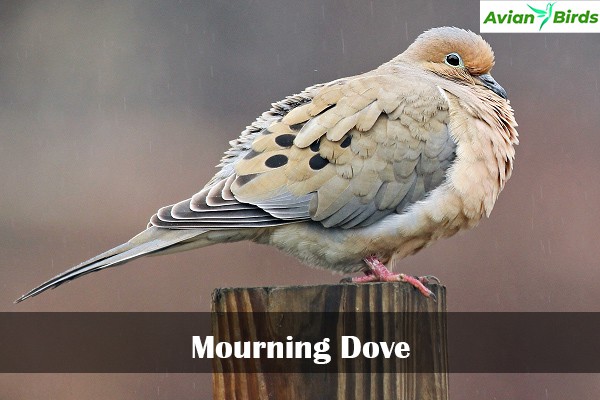4 Types of Doves (Pigeons) In Arkansas (With Pictures)
Did you know Doves in Arkansas is home to over 30 birds of species? Among them, four types of doves stand out. These include the Mourning Dove, Rock Pigeon, Eurasian Collared-Dove, and White-winged Dove. They show how diverse our state’s bird life is.
This article will dive into the world of these dove species in Arkansas. We’ll look at their unique traits, behaviors, and their place in our ecosystem. With beautiful images, we invite you to see the beauty of these birds that make our landscapes special.
Overview of Doves and Pigeons
The dove family is a group of birds that are very important in the world’s ecosystems. They are known for being gentle and living in groups. By learning about pigeon characteristics, we can see the differences and similarities within this bird family.
Doves are smaller than pigeons. Both have short necks and thin bills. But, doves have smooth, round bodies and long tails. Pigeons are bigger with wider bodies.
These birds love to eat seeds. This helps them play a big part in the environment. They spread seeds and are key to many ecosystems. For a long time, people have seen doves and pigeons as symbols of peace and friendship.
Studying these birds helps us understand and value doves and pigeons more. The dove family’s diversity makes us want to learn more about these amazing birds.
1. Mourning Dove
- Scientific Name: Zenaida macroura
- Size: 24–30 cm (9.1–11.8 in)
- Weight: 110–170 g (3.9–6.0 oz)
- Lifespan: 1–3 years (up to 8 years in the wild)
- Diet: Primarily seeds, but also fruits and grains.
The Mourning Dove is the most common dove in Arkansas. It stands out with its graceful look, grayish-brown feathers, and big black spots on the wings. The bright blue ring around its eyes makes it easy to spot.

Identifying Characteristics
Identifying the Mourning Dove is easy with its key features:
- Grayish color with warm brown undertones
- Large black wing spots
- Blue eye-ring surrounding each eye
- Long, pointed tail
Feeding Habits
The Mourning Dove loves to eat seeds, especially small grains and seeds on the ground. It can be seen in open areas, gardens, and fields. They feed on the ground in the early morning and late evening.
Breeding Behavior
In the breeding season, Mourning Doves show interesting behaviors. Females lay two eggs in nests made of twigs and grasses, usually in trees or shrubs. They can have many broods each year, playing a big role in the ecosystem. Both parents take care of the eggs and feed the chicks.
Vocalizations
The Mourning Dove’s soft “coo” calls are a common sound in the morning or late afternoon. These calls help with communication between mates and in defending territory. They add to the dove’s presence in nature.
We value the Mourning Dove in Arkansas for its unique traits, eating habits, breeding ways, and beautiful sounds. These features make it a special part of our environment.
2. Rock Pigeon
- Scientific Name: Columba livia
- Size: 30–35 cm (11.8–13.8 in)
- Weight: 240–380 g (8.5–13.4 oz)
- Lifespan: 3–5 years (up to 15 years in the wild)
- Diet: Seeds, grains, and fruits.
The Rock Pigeon is a common bird found in cities. It has adapted well to city life. They have stout bodies, short necks, and a variety of colors. Let’s look at their key traits, where they live, and their cultural importance.

Identifying Characteristics
Rock Pigeons stand out with their unique look. They have:
- Plump bodies, about 12 to 14 inches long.
- Broad wings and a small head, with a short, squared-off tail.
- Colors include gray, white, and brown, with two black wing bars.
Habitat and Behavior
These pigeons love urban life. You can find them in parks, squares, and near buildings. They like places with easy access to food, such as:
- Public spaces where people feed them.
- Areas with food that people have thrown away.
Rock Pigeons are social birds that live in groups. They roost together on rooftops or in safe spots. They use sounds and body language to talk to each other.
Cultural Significance
For over 5,000 years, Rock Pigeons have been close to humans. They have played many roles, like:
- Messengers in wars because they can find their way home.
- Racing companions.
In Arkansas, these birds symbolize peace and strength. They connect city life with nature. Their presence adds to the wildlife in our cities, making them a valued part of our environment.
Doves in other Regions:
3. Eurasian Collared-Dove
- Scientific Name: Streptopelia decaocto
- Size: 31–34 cm (12–13 in)
- Weight: 120–250 g (4.2–8.8 oz)
- Lifespan: 4–19 years
- Diet: Seeds, grains, and fruits
The Eurasian Collared-Doves has caught the eye of bird lovers in Arkansas. It stands out with its sandy brown color and a black neck collar. Let’s dive into its features, why it’s considered invasive, and its unique sounds.

Identifying Characteristics
This dove is medium-sized and sturdy. Its feathers are pale gray to light brown. The black collar on its neck is a clear sign. Its long, tapered tail adds to its beauty, especially when flying.
Invasive Species Status
The Eurasian collared dove is known as an invasive species in Arkansas, especially in cities. It has spread a lot since it was first introduced. It takes over the homes of native doves by eating seeds and grains.
Vocalizations
The Eurasian Collared-Dove makes a memorable sound, often heard as a “koo-KOO-kook”. This call is different from the Mourning Dove’s. Knowing these sounds helps us spot this dove more easily.
4. White-winged Dove
- Scientific Name: Zenaida asiatica
- Size: 28–30 cm (11–12 in)
- Weight: 150–200 g (5.3–7.1 oz)
- Lifespan: 3–4 years (up to 10 years in the wild)
- Diet: Seeds, fruits, and nuts
The White-winged Dove is a bird with a pale grayish-brown look and white stripes on its wings. They eat mainly seeds and fruits. These birds can live in many places, making them interesting for bird lovers.

Identifying Characteristics
To spot the White-winged Dove, look for these traits:
- Color: Pale grayish-brown body.
- Distinctive: Noticeable white wing stripes that stand out in flight.
- Size: Medium-sized dove, similar in size to the Mourning Dove.
Feeding Preferences
The White-winged Dove likes certain foods. They enjoy:
- Seeds like sunflower and millet.
- Fruits such as berries and figs.
- Grains from feeders or open ground.
Offering a variety of foods can help attract these birds.
Unique Abilities
The White-winged Dove has special skills. They drink water by tilting their heads. They also feed their young with crop milk, which is very nutritious. During mating, males make beautiful calls to find mates.
Doves in Arkansas: Habitat and Distribution
In Arkansas, doves live in many places, from cities to the countryside. They pick spots that help them survive. This shows how well they adapt to different environments.
Doves move around based on what they need for food, shelter, and living. For instance, mourning doves like open fields and farmlands for seeds. Rock pigeons prefer cities, hanging out near buildings and parks.
Let’s look at some dove species in Arkansas and where they like to live:
| Dove Species | Preferred Habitat | Distribution |
|---|---|---|
| Mourning Dove | Open fields, agricultural areas | Throughout Arkansas, more common in rural zones |
| Rock Pigeon | Urban areas, parks, and buildings | Widespread in cities and towns |
| Eurasian Collared-Dove | Suburban settings, near people | Increasing presence across the state |
| White-winged Dove | Wooded areas, semi-urban regions | Mostly in southern Arkansas |
Seeing where doves live in Arkansas helps us understand their adaptability. It makes us value these birds more. It also reminds us to think about their living spaces.
Tips for Spotting Doves in Arkansas
Birdwatching is a joy, especially when we spot doves in their natural spots. Knowing when and where to look for them makes our experiences better. It’s important to understand their seasonal behaviors and the best times to see them.
Best Times for Viewing
Early mornings and late afternoons are the best times to see doves. These hours are when they are most active, looking for food and socializing. Here are some tips to help you spot doves:
- Look for open fields and pastures where doves like to eat.
- Check out ponds and lakes early, as doves may come to drink.
- Don’t forget to visit urban areas, where doves often go to bird feeders and gardens.
Using these tips can really help us see the beauty of doves in Arkansas.
How to Attract Doves to Your Backyard
Creating a welcoming space for doves in our backyard is rewarding. It involves strategic feeding and understanding what makes them feel safe and comfortable. By following these tips, we can attract different dove species.
Feeding Recommendations
Choosing the right feeders is key to attracting doves. We recommend using platform feeders for easy access. Here are some great food options:
- Whole seeds such as millet, sunflower seeds, and corn
- Mixed grain blends specifically designed for doves
- Providing food on the ground, as doves often prefer foraging
Keeping these foods available can really help attract doves and make them feel welcome.
Environmental Considerations
Creating a safe space is crucial for doves. Here are important points to think about:
- Use dense shrubs or small trees for shelter from predators.
- Make sure there’s a clean, dry spot for nesting.
- Keep a water source around for drinking and bathing.
By focusing on these environmental factors, we can make our yards more inviting for doves. This encourages them to visit more often.
| Feeder Type | Best Foods | Advantages |
|---|---|---|
| Platform Feeder | Mixed grains, Corn | Easy access for ground feeders |
| Tube Feeder | Sunflower seeds | Reduces waste from ground feeding |
| Ground Feeding Area | Whole seeds | Natural foraging behavior |
Photography Tips for Capturing Doves
We’re excited to share tips for capturing doves in their natural settings. These beautiful birds offer great photo opportunities. With the right approach, we can improve our dove photography skills.
Choosing the right gear is key. A camera with a good zoom lens lets us get close without scaring the birds. A lens with a focal length of 200mm or more is ideal for capturing birds in flight or from afar.
When setting up our camera, we should aim for faster shutter speeds. Doves fly quickly, so settings of 1/1000 second or faster can freeze their movement. Using continuous shooting mode increases our chances of getting the perfect shot.
Finding great spots to photograph doves is important. Look for places where they hang out, like parks or gardens with bird feeders. Early mornings or late afternoons are best for great lighting.
Getting close to doves requires a gentle touch. Being quiet and patient helps us get closer without scaring them. Wearing neutral colors helps us blend in with the surroundings.
In summary, capturing doves well means having the right gear, settings, locations, and patience. By following these tips, we can improve our wildlife photography and capture the beauty of these birds.
| Tip | Description |
|---|---|
| Equipment | Use a camera with a good zoom lens of at least 200mm. |
| Camera Settings | Set a fast shutter speed (1/1000 second) and use continuous shooting mode. |
| Location | Find parks or gardens with bird feeders; early morning and late afternoon are best. |
| Approach | Be quiet, and patient, and wear neutral colors to avoid disturbing them. |
Read More🐦Related Articles:
| Hummingbirds in Missouri |
| Swan Spiritual Meaning |
| Birds in Spain |
| Small Birds with Long Beaks |
| Birds That Lay Blue Eggs |
Conclusion
As we wrap up our look at doves in Arkansas, we see how important they are to our ecosystem. We’ve learned about the Mourning Dove, Rock Pigeon, Eurasian Collared-Dove, and White-winged Dove. These birds are not just beautiful; they play a big part in keeping nature in balance.
Learning about doves makes us want to watch birds and learn more about them. It helps us appreciate and protect their homes. We should all try to see the beauty of doves in our daily lives.
Let’s take a moment to watch these amazing birds in the wild. Maybe we can even put up feeders to draw them in. By helping with conservation, we can make sure future generations can enjoy doves too. Let’s work to protect these lovely birds and learn from them.







